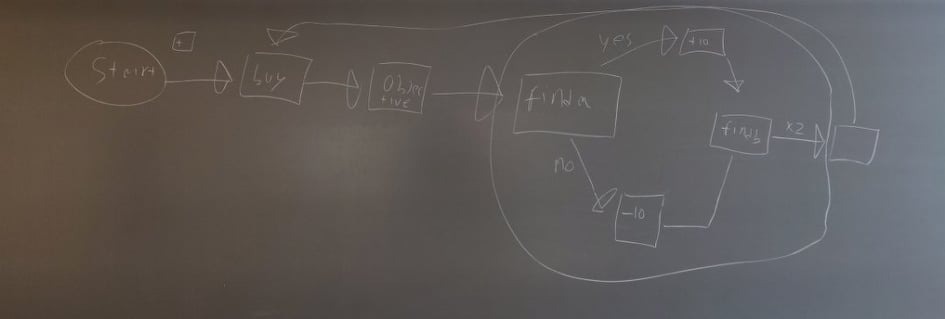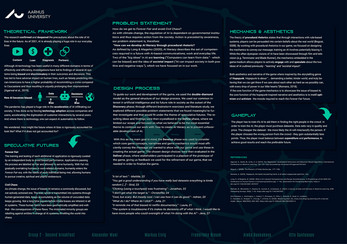F.AI.R
A downloadable game for Windows

Game description
A game by Second breakfast made for the summer course Game.play.design at Aarhus University
Gameplay video:
Our game is constructed with procedural rhetorics in mind, with the goal of creating a game that, via the use of mechanics, simulates how artificial intelligence is built and tested, and can provide an aesthetic experience of learning. To accomplish this, we ended up appealing to achievers in our game. To stimulate this playertype, we developed a pointscore. The choice to include a point score was made definitively after our game test, as play testers struggled to follow their progress in the game.
We chose the achiever player type, as grading systems exist in the majority of educational systems, creating a mechanic in which the achiever player can strive to excel. This means that in order to motivate learning, all that is required to engage an achiever is for the strategy that earns the most points to coincide with the strategy that creates the desired procedural rhetoric. Which is why, in FAIR, we provide a score for correctly estimating the target person's attributes, which is best accomplished through the acquisition of a wide set of datasets. Additionally, we realize that achievers might be of two minds; those who are more competitive are given a highscore mechanic to pursue in order to drive repetitive play, while those who are more narrative oriented are offered the attraction of a "best ending" to pursue.
By utilizing procedural rhetorics in our game, we were able to concentrate on building the mechanics that would express our message; teaching an AI entails the possibility of bias. The game-mechanisms enable players to actively participate with and hypothesize on the two concepts of AI discussed in our portfolio 1 - "learning" and "societal impact."
Both the graphics and plot of the game were influenced by the Hopepunk storytelling genre. If the game mechanics' primary purpose is to highlight the issue of biased AI, the hope of punk-inspired narrative and aesthetics' primary purpose is to instill optimism and activism - the moods required to achieve the Forever Fair future.
Theoretical framework
As a newly formed group, we quickly discovered our shared interest for artificial intelligence (AI). Pondering this whilst keeping the post-pandemic theme in mind, we discussed the future problems with AI bias as AI usage increases in society:
- The research confirmed and deepened the precautions about the role of AI bias in the future.
- During the past decade the world has seen a plethora of successful AI application, from diagnostics (Floridi, 2020), to a single algorithm mastering multiple and different games (Schrittwieser et al., 2020), to triumphing at protein folding (Jumper et al., 2021). Algorithms recommend movies, products, romantic partners, hires and loan decisions.
- Although AI-technology has been useful in many different domains in terms of effectivity and efficiency, investigations have led to findings of several AI systems being biased and discriminatory in their outcomes and decisions. This has led to have adverse impact on human lives, such as falsely predicting African-Americans to have a higher probability of recommitting a crime compared to Caucasians and thus resulting in unjustly prolonging their imprisonment (Agarwal et al., 2019). This bias emanates from the “fuel” that is used to train the AI to make predictions - the data. Data may seem to be impartial and neutral by nature, but since data is gathered by humans with preconceptions and prejudices, they can carry these biases into the AI, unintentionally giving rise to biased AI (Mehrabi et al., 2021)
- The pandemic has played a huge role in the acceleration of AI infiltrating our society. It has done so by forcing technology adoption across companies and users, accelerating the digitization of customer interactions by several years. And where there is technology, one can expect AI automation to follow.
- We wondered. How might the future where AI bias is rigorously accounted for look like? What if it does not get accounted for?
Problem Statement
How do we get to Forever Fair and avoid Civil Chaos?
As defined by Long & Magerko (2020), AI literacy describes the set of competencies required in a future with AI-based communications, work and everyday life. Two of the “big ideas” in AI are learning (“Computers can learn from data.” - which can be biased) and the idea of societal impact (“AI can impact society in both positive and negative ways.”), which we have focused on in our work.
Our problem statement is, therefore: How can we develop AI literacy?
- To guide our work and development of the game, we used the double-diamond model as the general structure of our design process. We used our common interest in artificial intelligence and its future role in society as the outset of the Discovery phase; through different brainstorm exercises and literature study, we explored different possible problem statements that we found meaningful to further investigate and that would fit under the theme of speculative futures. The resulting ideas and findings were then crystallized in the Define phase, where we limited our scope and focused on what we believed to be the most essential theme to continue our work with: how to create AI literacy as to prevent unfavorable development of AI. With this as the main goal in mind, the Develop phase was used to consider which core game concepts, narratives and game mechanics would most efficiently convey the message we wanted to show with our game and use these in creating the actual game. The chosen design choices were then evaluated in the Deliver phase, where stakeholders participated in a playtest of the prototype of the game, giving us feedback we could use in the refinement of our game, that we needed in order to finalize the game.
Design decisions
- The theory of procedural rhetorics states that through interactions with rule-based systems, players can be persuaded into certain beliefs about the real world (Bogost, 2008). By working with procedural rhetorics in our game, we focused on designing the mechanics to convey our message; training an AI involves potentially biasing it. While the often dystopian visions of AI have been showcased through film and television (e.g. Terminator and Blade Runner), the mechanics embedded in the game-medium allows players to actively engage with and speculate about the two ideas of AI outlined previously - “learning” and “societal impact”.
- Both aesthetics and narrative of the game where inspired by the storytelling genre of Hopepunk. Hopepunk is about “... demanding a better, kinder world, and truly believing that we can get there if we care about each other as hard as we possibly can, with every drop of power in our little hearts.” If the core function of the game mechanics is to showcase the issue of biased AI, the core function of the hopepunk-inspired narrative and aesthetics is to instill optimism and activism - the moods required to reach the Forever Fair future.
Development:
Below is a few key elements that lead our thinking during the design process

Playertypes
During our theorectical research we found Bartles playertypes as piece of theory worth using especially when mixed with procedual rhetorics, as it gives us ways to question what types of player might learn most from the mechanics.
Bartles playertypes, is a framework based on countless forum posts and interviews with creators and moderators of "MUDS" which is a type of old school MMO. Based on these pieces of information Bartle divided the players of these MUDS into four types socialiser and killers, player who interacting and act with other players, explorers and achievers, player who act upon and interact with the world.
Since our game is a singleplayer game that focuses on narrative aspects it primarily fits to players who are explorers and achievers as they do not require other players to interact with. But here an interesting junction appears, as we ask ourselves who might learn the best?
We put our money on the achiever player type, as something found within most education system is the grading system, which creates a mechanic the achiever player can strive to achieve the highest in, this means that in order to motivate learning all that is needed to engage an achiever is that the strategy giving the most points coincides with the strategy which creates the desired procedual rhetoric dynamic. Which is why in F.AI.R we include score which is gained from guessing all the apects of the targeted person correctly, an action best achieved through the purchase of a diverse set of datasets. We also recognize that achievers can be of two minds, the more competetively minded achievers are given a highscore mechanic to chase after to encourage repetetive play, and the more story minded gain the allure of a "best ending" to chase after.
Playtest: the what
During the third day of F.AI.R's creation we held a a playtest involving stakeholders, chosen based on their knowledge about AI and relation to our work group, as the scope for the project only afforded proper testing using the circle of "friends and family".
These test were at set of think aloud test were the player would sit down with the game after an icebreaker and say every thought that came to mind. The goal of this was to evaluate the games ability to teach the desired values of AI literacy and see how well the players understood the goals and controls of the game.
Playtest: results
The results of our playtest was an overhaul of the games UI elements, as many testers did not understand what their goals during the game was, originally small snippets of real seeming text was present during the beginning phase and the "buy phase" of the game but this text confused the players more so than it helped.
So we added more clear text and a "primer" at the beginning to help the players understand their goals and how the mechanics functioned.
Another aspect of a similar issue was a lack of failure state, to fix this issue we added multiple endings and more primers within the game to try and nudge the player towards replaying the game.
We did also find that many players did not learn about the ways in which AI became biased, but one tester who had previous knowledge about how AI could be biased noted that the game reminded them of it, we chalked that up as the games mechanics succeeding in delivering the desired procdeual rhetoric but not priming player to think along those lines enough to get the message.
| Status | Prototype |
| Platforms | Windows |
| Author | Von Gnome |
| Genre | Educational |
| Tags | 3D, Management, Point & Click, Sci-fi, Short, Singleplayer |
Download
Install instructions
Download the zip file, unzip it and play :D



Leave a comment
Log in with itch.io to leave a comment.